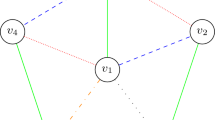Abstract
It has been known for almost three decades that many NP-hard optimization problems can be solved in polynomial time when restricted to structures of constant treewidth. In this work we provide the first extension of such results to the quantum setting. We show that given a quantum circuit C with n uninitialized inputs, p o l y(n) gates, and treewidth t, one can compute in time \((\frac {n}{\delta })^{\exp (O(t))}\) a classical assignment y∈{0,1}n that maximizes the acceptance probability of C up to a δ additive factor. In particular, our algorithm runs in polynomial time if t is constant and 1/p o l y(n)<δ<1. For unrestricted values of t, this problem is known to be complete for the complexity class QCMA, a quantum generalization of MA. In contrast, we show that the same problem is NP-complete if t = O(logn) even when δ is constant. On the other hand, we show that given a n-input quantum circuit C of treewidth t = O(logn), and a constant δ<1/2, it is QMA-complete to determine whether there exists a quantum state \(|\varphi \rangle \in ({\mathbb {C}}^{d})^{\otimes n}\) such that the acceptance probability of C|φ〉 is greater than 1−δ, or whether for every such state |φ〉, the acceptance probability of C|φ〉 is less than δ. As a consequence, under the widely believed assumption that QMA≠NP, we have that quantum witnesses are strictly more powerful than classical witnesses with respect to Merlin-Arthur protocols in which the verifier is a quantum circuit of logarithmic treewidth.





Similar content being viewed by others
Notes
In the case of classical circuits, it is assumed that each variable labels a unique input of unbounded fan-out.
All graphs in this work, being directed or undirected, may contain multiple edges, but no loops.
References
Aharonov, D., Kitaev, A., Nisan, N.: Quantum circuits with mixed states. In: Proceedings of the 30th Symposium on Theory of Computing, pp. 20–30 (1998)
Aharonov, D., Naveh, T.: Quantum NP - Asurvey. Eprint arXiv:quant-ph/0210077 (2002)
Alekhnovich, M., Razborov, A.A.: Satisfiability, branch-width and Tseitin tautologies. In: Proceedings of the 43rd Symposium on Foundations of Computer Science, pp. 593–603 (2002)
Allender, E., Chen, S., Lou, T., Papakonstantinou, P.A., Tang, B.: Width-parametrized SAT: Time–space tradeoffs. Theory Comput. 10(12), 297–339 (2014)
Arnborg, S., Lagergren, J., Seese, D.: Easy problems for tree-decomposable graphs. J. Algorithms 12(2), 308–340 (1991)
Arnborg, S., Proskurowski, A.: Linear time algorithms for NP-hard problems restricted to partial k-trees. Discrete Appl. Math. 23(1), 11–24 (1989)
Babai, L.: Bounded round interactive proofs in finite groups. SIAM J. Discret. Math. 5(1), 88–111 (1992)
Bodlaender, H.L.: Classes of graphs with with bounded treewidth. Bull. EATCS 36, 116–126 (1988)
Bodlaender, H.L.: NC-algorithms for graphs with small treewidth. In: Proceedings of the 14th International Workshop on Graph-Theoretic Concepts in Computer Science, volume 344 of LNCS, pp. 1–10. Springer (1989)
Bodlaender, H.L., Fomin, F.V., Koster, A.M., Kratsch, D., Thilikos, D.M.: On exact algorithms for treewidth. ACM Trans. Algorithms 9(1), 12 (2012)
Bookatz, A.D: QMA-complete problems. Quan. Inf. Comput. 14(5-6), 361–383 (2014)
Broering, E., Lokam, S.V.: Width-based algorithms for SAT and CIRCUIT-SAT. In: Proceedings of the 6th International Conference on Theory and Applications of Satisfiability Testing, volume 2919 of LNCS, pp. 162–171. Springer (2004)
Courcelle, B.: The monadic second-order logic of graphs I. Recognizable sets of finite graphs. Inf. Comput. 85(1), 12–75 (1990)
de Oliveira Oliveira, M.: On the satisfiability of quantum circuits of small treewidth. In: Proceedings of the 10th International Computer Science Symposium in Russia, volume 9139 of LNCS, pp. 157–172. Springer (2015)
Georgiou, K., Papakonstantinou, P.A.: Complexity and algorithms for well-structured k-SAT instances. In: Proceedings of the 11th International Conference on Theory and Applications of Satisfiability Testing, volume 4996 of LNCS, pp. 105–118. Springer (2008)
Gottesman, D.: The Heisenberg representation of quantum computers. arXiv:quant-ph/9807006 (1998)
Impagliazzo, R., Paturi, R.: On the complexity of k-SAT. J. Comput. Syst. Sci. 62(2), 367–375 (2001)
Jozsa, R., Linden, N.: On the role of entanglement in quantum-computational speed-up. Proc. R. Soc. London Series A 459(2036), 2011–2032 (2003)
Kitaev, A., Shen, A., Vyalyi, M.: Classical and Quantum Computation, Volume 47 of Graduate Studies in Mathematics. AMS (2002)
Markov, I.L., Shi, Y.: Simulating quantum computation by contracting tensor networks. SIAM J. Comput. 38(3), 963–981 (2008)
Nielsen, M.A., Chuang, I.L: Quantum Computation and Quantum Information. Cambridge University Press (2010)
Robertson, N., Seymour, P.D.: Graph minors III. Planar tree-width. J. Comb. Theory, Series B 36(1), 49–64 (1984)
Robertson, N., Seymour, P.D.: Graph minors XIII. The disjoint paths problem. J. Comb. Theory, Series B 63(1), 65–110 (1995)
Thilikos, D.M., Serna, M.J., Bodlaender, H.L.: Constructive linear time algorithms for small cutwidth and carving-width. In: Proceedings of the 11th International Conference on Algorithms and Computation, volume 1969 of LNCS, pp. 192–203. Springer (2000)
Valiant, L.G.: Quantum circuits that can be simulated classically in polynomial time. SIAM J. Comput. 31(4), 1229–1254 (2002)
Vidal, G.: Efficient classical simulation of slightly entangled quantum computations. Phys. Rev. Lett. 91, 147902 (2003)
Watrous, J.: Succinct quantum proofs for properties of finite groups. In: Proceedings of the 41st Symposium on Foundations of Computer Science, pp. 537–546 (2000)
Acknowledgments
This work was supported by the European Research Council, ERC grant agreement 339691, within the context of the project Feasibility, Logic and Randomness (FEALORA).
Author information
Authors and Affiliations
Corresponding author
Additional information
This is an extended version of a paper that appeared at CSR 2015 [14].
Rights and permissions
About this article
Cite this article
Oliveira Oliveira, M.d. On the Satisfiability of Quantum Circuits of Small Treewidth. Theory Comput Syst 61, 656–688 (2017). https://doi.org/10.1007/s00224-016-9727-8
Published:
Issue Date:
DOI: https://doi.org/10.1007/s00224-016-9727-8




